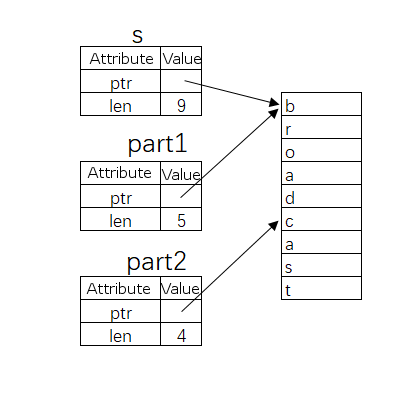Rust Slice Type
A Slice is a partial reference to a data value.
The name “slice” often appears in biology class. When we make sample slides, we have to take sections from organisms for observation under a microscope. In Rust, slicing means roughly the same thing, except that it isreferenced from data.
String slicing
The simplest and most commonly used data slicing type is string slicing.
Example
fn main() {
let s = String::from("broadcast");
let part1 = &s[0..5];
let part2 = &s[5..9];
println!("{}={}+{}", s, part1, part2);
}
Running result:
broadcast=broad+cast

The figure above illustrates the principle of string slicing (Note: string types in Rust essentially record the starting position and length of characters in memory, as we learned for the time being).
Use .. syntax for indicating the scope has appeared in the looping chapter. x..y represents the mathematical meaning of [x, y) There can be no operands on .. both sides:
.. Y is equivalent to 0.. Y
x. Equivalent to position x to end of data
Equivalent to position 0 to end
Note: so far, try not to use non-English characters in strings because of coding problems. The specific reasons will be described in the “string” section.
A string referenced by a slice prohibits changing its value:
Example
fn main() {
let mut s = String::from("runoob");
let slice = &s[0..3];
s.push_str("yes!"); // error
println!("slice = {}", slice);
}
This procedure is incorrect.
S is partially referenced and it is forbidden to change its value.
In fact, so far you must be wondering why you have to write this every time you use a string. String::from("runoob") write directly "runoob" , Can’t you?
At this point, we must tell the difference between the two concepts. There are two common string types in Rust: str and String . str is the Rust core language type, which is the string slicing (String Slice) thatthis chapter has been talking about, often in the form of references (& str).
The overall type property of all string constants enclosed in double quotes is &str :
let s = "hello";
Here s is just one. &str a variable of type.
String type is a data type provided by the Rust standard common library,and it is more functional-it supports practical operations such as string appending and emptying. String and str in addition to having a character start position attribute and a string length attribute, there is also a capacity attribute.
String and str are all support slicing, and the result of slicing is &str type of data.
Note: the slicing result must be a reference type, but the developer must make this clear for himself:
let slice = &s[0..3];
There is a quick way to change the String convert to &str :
let s1 = String::from("hello");
let s2 = &s1[..];
Non-string slice
In addition to strings, some other linear data structures also support slicing operations, such as arrays:
Example
fn main() {
let arr = [1, 3, 5, 7, 9];
let part = &arr[0..3];
for i in part.iter() {
println!("{}", i);
}
}
Running result:
1
3
5